(first posted 8/6/2012) The Fleetwood Brougham. The top-of-the-line Cadillac. Luxurious in space, in gadgets, and in power. The best “owner-driven” Cadillac money could buy. While Cadillac wasn’t necessarily the top pick for rolling status symbols by 1975 – Mercedes and BMW were making serious inroads by mid-decade – it was still the go-to vehicle for traditional American luxury – padded vinyl top, opera lamps, and all.
All Cadillacs save the Eldorado used the body shell introduced for the 1971 model year, updated with the expected annual front and rear end styling changes. As has been related here many times (click here for the ’72 Cadillac CC), the ’71s were not quite as exclusive or luxurious as their immediate predecessors, thanks to Cadillac Motor Division’s pursuit of ever-higher production goals.
It worked, but we could spend all day discussing whether that was a good or bad thing in the long run. Cadillac set a record in 1973, producing 304,839 cars – including, for good measure, the five-millionth Cadillac built. I bet lots of Cadillac executives were high-fiving each other that year.
The 1974 models received a bit more than a nose job. In order to comply with new bumper regulations, Cadillac added a “park bench” 5-mph front bumper along with a much more substantial rear bumper. The subtly redone sheet metal now featured blockier surfacing.
Taillights were no longer set into the rear bumper, but instead were built into GM’s ever-frail filler panels between the bumper and the trunk lid. Production-wise, things were not as cheery as they were in 1973, as Gas Crisis I arrived at about the same time as the ’74 Caddys. Model year production dropped substantially, by about 60,000. What was a luxury car maker to do?
Restyle, of course. Given the typical three-year design timeframe for new models, the downsized ’77s were probably in the works – and nowhere near ready – by the time the ’75 Cadillacs were introduced to dealer principals on September 19, 1974. Cadillac had little choice but to continue their current offerings until Phase I of the Cadillac downsizing – the import-fighting 1976 Seville – debuted in April of 1975.
Despite all the West Coast swells getting into Mercedes 280s and BMW Bavarias, there were still plenty of folks who equated Cadillac with the pinnacle of success. Those traditional buyers were Cadillac’s bread and butter. Even at this time, perhaps Cadillac execs thought that their full-size line would continue to be their biggest seller, and that the Seville was merely a “one-stater” made necessary by those unpredictable Californians’ car-buying habits. Eventually, that perception would be corrected but that’s beyond the scope of this article.

So, just what was new? The usual. Up front, the Fleetwood, de Ville and Calais got a revised eggcrate grille. The biggest talking point was most likely new quad rectangular headlamps. After having been displayed on Detroit show cars for years, square headlamps were finally legal for use on passenger cars. All 1975 Cadillacs, the Buick Riviera and Electra, and the Olds Ninety Eight and Toronado got them. It was a really big deal, perhaps as big a deal as quad round headlights were in 1958.
The ’75 Fleetwood Brougham dropped the Sixty Special moniker, a nameplate that would not return until the late ’80s. Originally, the Sixty Special nameplate signified the nicest “owner-driven” Fleetwood, while the Fleetwood Brougham added a padded vinyl roof. When the steel-topped version bowed out after 1970, the remaining vinyl-roofed version became the Fleetwood Sixty Special Brougham. It was a bit much, even for Cadillac, so perhaps the name change was for the best.
Other new features included revised wheel covers, taillights, and upholstery trim. I really like the 1975-76 Cadillacs. Sure, they’re gigantic, yet they have a fluidity of movement. You can tell this car was styled and not designed by a committee. I can imagine Paul rolling his eyes, so I’ll stop now.
A new interior option for the Brougham, shown on today’s CC, was shirred Monticello velour. Looks like your Great-Aunt Ethel’s parlor, doesn’t it? Bolsters? Lumbar support? What are those? Most Cadillac buyers probably couldn’t have cared less. Be that as it may, this was top American-style luxury, circa 1975. I had the pleasure of sitting in this car and I can tell you it was most cushy. A very nice place to be.
Here’s what you got over a Sedan de Ville. That three extra inches all went into the rear compartment. Such room! And I love the fold-out, carpeted foot rests. Even basketball players would not be lacking room back here.
As ’70s-tastic as the Monticello velour is, I would have sprung for the Sierra grain leather myself. Maybe it’s the advertising that’s swaying me…
At introduction, the Fleetwood Brougham set you back $10,414 ($44,419 adjusted). But inflation, which was routine in the mid-’70s, twice bumped up the price during the model year – first to $10,424, and later to $10,843. Back then, sticker shock was a fact of life of new-car shopping, but most Cadillac owners probably weren’t too worried about it. You got a lot of luxury and power, but one thing you didn’t get was instrumentation beyond a speedometer, fuel gauge and clock.
One thing that wasn’t lacking was “simulated wood veneer.” This car even has a CB radio. It also looks to have the built-in 8-track player and built-in litter basket (a standard feature). And just look at that chrome Brougham badge. You know you’ve arrived!
Today’s Curbside Classic is a mint-condition car with 38,000 miles on it. It is interesting to read the original window sticker (click for a bigger picture), which is still with the owner’s manual. This car is loaded with options, like Cerise Firemist paint ($139) and an AM/FM Stereo Radio/Tape Player ($89). And what’s this? Opera lamps cost extra? Apparently they did. It is also interesting that a passenger-side remote mirror still cost extra, even on a Fleetwood Brougham.
I always keep a camera in the car because you never know what you’re going to find. I went up to my folks’ cabin in Northern Illinois and was wandering around Freeport when I came upon this most excellent Caddy at the local GM dealership. Of course I had to stop!
This is a beauty. The former owner of this dealership was the first owner of this Fleetwood, and when he recently passed away, the dealership started liquidating his collection of 30+ vintage Cadillacs.
Gary, a salesman at the dealership, greeted me and was more than happy to open up the car when I explained about Curbside Classic. The sales manager, Chuck, was able to give me some of the car’s history, which was a big help. It’s nice to be able to put a car’s personal history in context, which is not always possible when finding cars “in the field.”
This car looks just great, and I hope it finds a new owner who will love it and keep it as it is – a time capsule to a time when 500-cu in V8s, velour upholstery and 234-inch-long Fleetwoods could be found at your local Cadillac dealer. Just two years later, the Fleetwood Brougham would be downsized and share the same overall dimensions as the deVilles – no more unique wheelbase. And those carpeted rear footrests would disappear in 1978.
The 1971-76 Cadillac was the last true, unapologetically gigantic Cadillac, and the Fleetwood Brougham was the best of them all. Yes, Cadillacs have changed a whole lot in the last 30-odd years, but when I recently saw a black-on-black XTS in the metal at the dealer in Moline, I have to tell you, my first thought was “2012 Fleetwood.”
























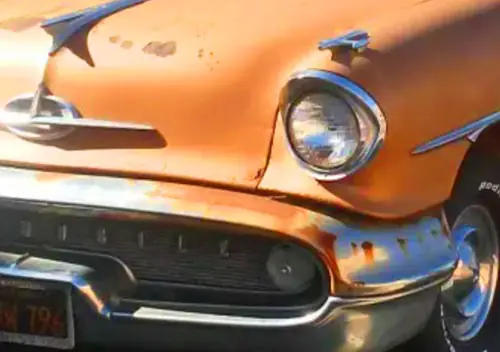
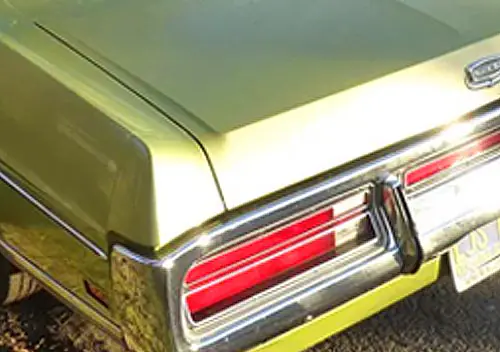
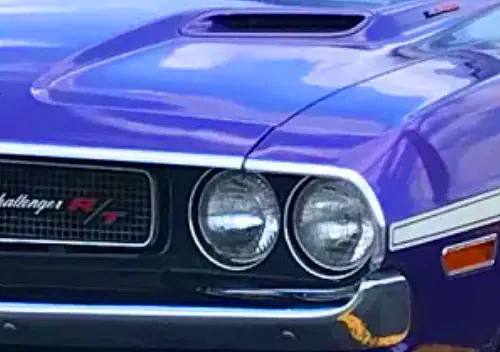

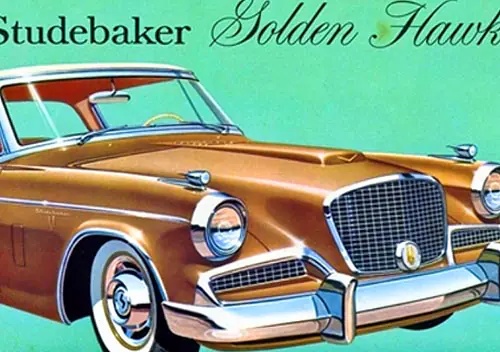
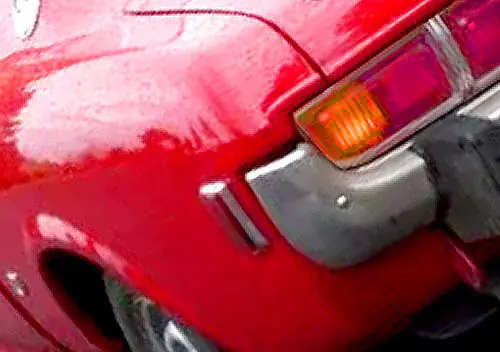
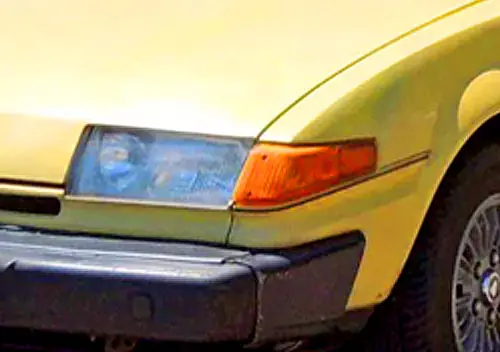
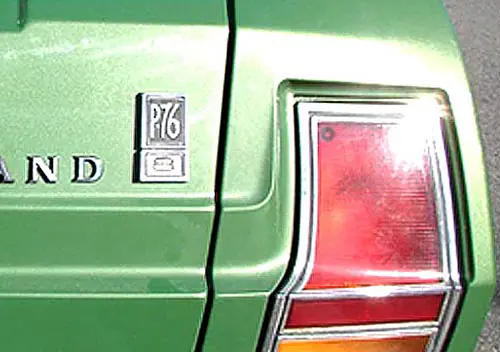
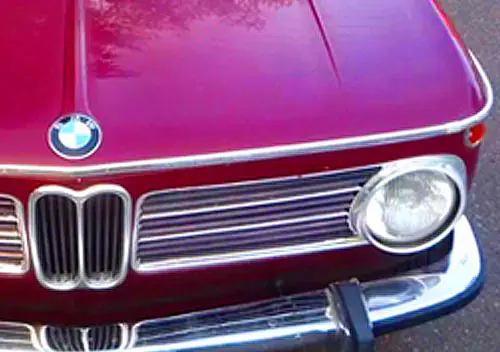
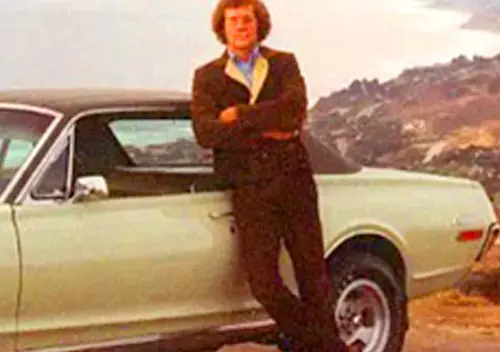
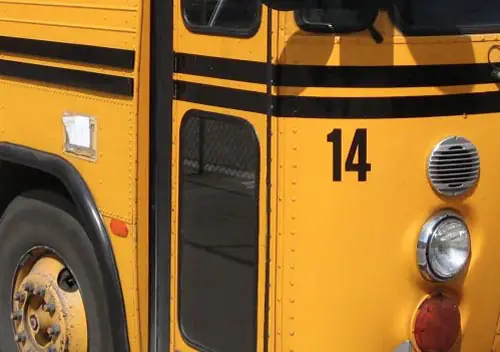
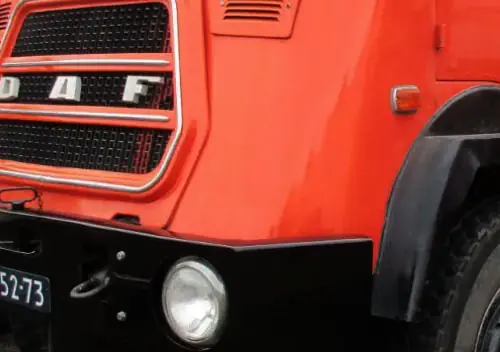
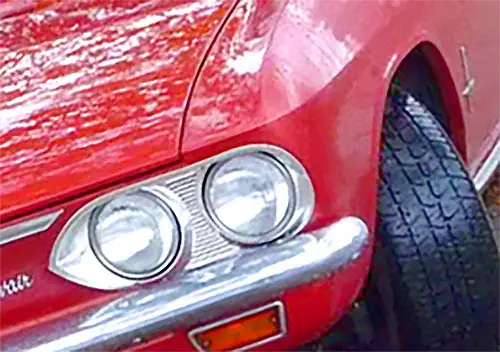
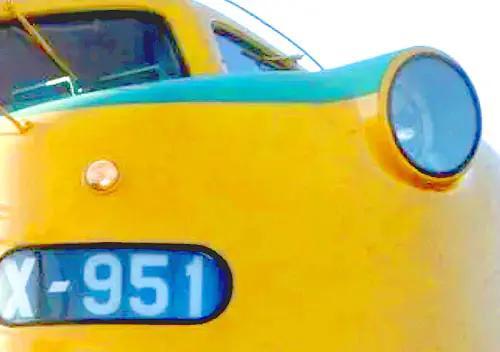
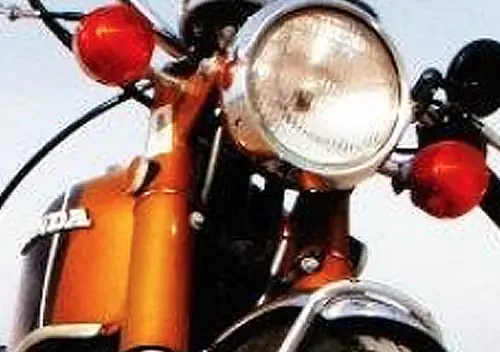
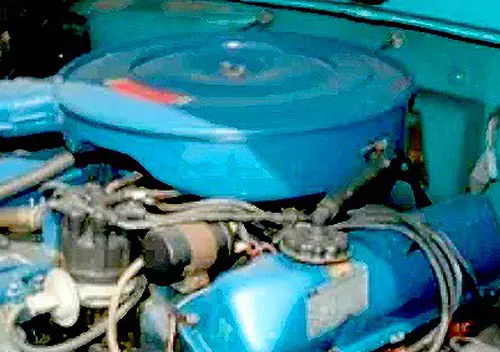
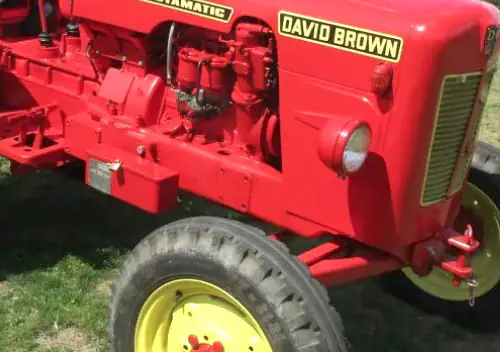
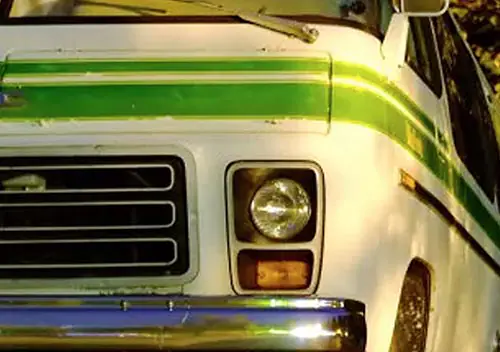

OMG, that brown shirred Monticello velour on the seats in the ad, it’s so bad, it’s good. I want one.
Agree, the only thing that could improve paisley velour is two-tone paisley velour.
Funny, I don’t recall seeing that upholstery pattern when I visited Jefferson’s Monticello…but maybe I missed it.
That sierra grain leather interior sure looks inviting. You can still find seats like that today… on private jets.
My sole experience with this generation Cadillac saw me packing the trunk of one every September when the elderly lady who lived next door to my grandmother (where I lived during college) would pay me $10 and a plate of fresh-baked cookies to load her up for her trip to winter in Florida. She would always remind me to “don’t slam the trunk, it will close by itself the last couple inches.”
She would always remind me to “don’t slam the trunk, it will close by itself the last couple inches.”
Ah, yes, my Dad would always issue the same reminder. Those power trunk closers were a bit of a paradox. They were designed to spare the owner the indignity of having to slam the trunk lid, but if slammed – either by an absent-minded owner or an uninformed golf caddy or bag boy – the mechanism would get thrown out of adjustment, or worse, broken. You’d think that they would’ve been designed to stand the abuse of people who were accustomed to closing trunk lids on lesser cars.
I lived the same thing with my 63 Fleetwood and my 89 Brougham. I think, on balance, it was more work as a Cadillac owner to constantly tell everyone else “don’t slam the trunklid” than it would have been to have to slam the trunklid like any other car.
One of the main “reasons” for the power trunk lid pull down was to not disturb the passengers of the car when the trunk lid is slamed.
Good point, Carmine…but I may never live long enough to understand why they didn’t make the dang thing robust enough to survive the slams of a hamfisted supermarket bag boy, who is from a home in which he never got the chance to get up close and personal with a Cadillac, yet alone operate its unique trunklid.
One fine Saturday, the closer on my Dad’s ’84 – which was a nightmare in and of itself – once got stuck in a cycle where the closer would pull the lid down, then not catch and trunklid would pop up about an inch or so, then the closer would pull the lid down, then not catch and trunklid would pop up about an inch or so, then the closer would pull the lid down…we had to pull the fuse to stop the madness, and then we were left with a trunklid that was not quite closed, and remained so until we got to the dealer on Monday. Not coincidentally, that issue was one of many that made it our last Cadillac.
I had a 1967 Lincoln Continental 4-door sedan at one time and it had a trunk button in the glove compartment. So you opened the glove, pressed down on the button and up popped the monster-sized trunk lid. No need for the key. But you did have to (lightly) slam the trunk to shut it. No automatic ‘last few inches’ to close.
My 2000 BMW wagon has precisely the same problem. I just last weekend had to take the trim off the tailgate and fiddle with it. There is a lesson there somewhere.
True! I think that this device dates back to the 50’s. My grandmother had a ’55 Coupé DeVille with most power options, and among these was the power trunk lid pull down. Very exotic for many who didn’t know the operation of it in that time. And in my ’91 Sedan DeVille I have to tell everyone who tries to close it how to do it to avoid damages. Really, a fancy device but very expensive to repair.
Yes, my ignorant ass learned that the hard way when I was loading groceries for a nice elderly lady who patronized the grocery store where I worked during college. My boss was not happy.
It seems a strange feature. I understand its intent, from Carmine’s comment, but unless you were used to Cadillacs, you’d never expect it. I can see golf caddies being used to this feature on Caddies, but not the humble supermarket bag boy. Do Cadillac owners do their own shopping, or does the cook or maid do it for them? 😉
Beautiful car. I would so much love to have one of these. I’m particularly fond of the ’75-’76 versions too. The dash is incredible with its very long row of warning lights in a row on the very top…in-line with the digital clock & fuel gauge.
I also liked the wheelcovers on these: elegant yet easy to clean. Sure beats wire wheelcovers — blecch! It takes hours to clean those things.
When I was a kid, my dad bought a ’76 Eldorado Convertible with red interior. It had the same dash as the feature car. The hood was so massive, it actually had two separated catches in the front.
It’s strange that Tilt was optional on these cars…it was standard equipment on the Rivieras for years.
It’s also odd that Cadillac didn’t put a stand-up hood ornament on these (heck, my ’74 Malibu Classic has one!) The Cadillac crests & Cadillac crest/wreaths are really beautiful pieces, especially when viewed from behind the wheel.
BTW, thanks for posting the window sticker — that kind of thing is right up my alley. It’s always fascinating to see how these cars were ordered.
The dash is certainly interesting, but in my experience was a victim of GM 1970s cost cutting. The touch surfaces everywhere on the dash felt cheap. That long row of idiot lights was a cool design feature (if you have to have idiot lights) but the rest of it was a cheap band of black plastic.
The hood ornament thing was interesting. I can remember that the 72 Conti Mark IV was the first car to bring back the hood ornament, this time with a spring. Thereafter, everybody in the 1970s wamted one. The worst thing on the Cadillacs was where folks would have a hood ornament put on – immediately above the identical emblem on the leading edge of the hood. It just looked bad (except, I guess, from the drivers seat).
My problem with these cars was that around that same time I owned a 63 Fleetwood. Everything you touched in that car said “careful, Junior – this is expensive.” By the time this one was made, everything was plastic, and not expecially good plastic, either. If only GM could have fitted these cars with a body/interior worthy of the high-quality mechanicals of these cars.
Interestingly, the dash was upgraded in the 74 restyle. The 71-73 dash was much worse. In fact, it looked exactly like Chevy. This dash was actually class leading, because it was much different than those used in lesser GM brands. Contrast to Lincoln and Imperial, who began sharing dashboards and steering wheels with other divisions.
That Bakelight steering wheel (aka soy) was thin as could be, but at least felt smooth and cool in your hands. Problem was, though, that by 100,000 miles, the wood trim inlay would peel right off.
Again, 1971 Eldorado also had a stand up hood ornament.
You raise good points about the 71 Eldo, things that I have forgotten (if I ever knew them in the first place.) At that point in time (about age 12 or so), I was quite over Cadillac and was a dedicated Lincoln man. Was the Eldo hood ornament a standard equipment item? I know that it was on the 72 Mark. Just like some owners of Mark IIIs insisted of having a hood ornament installed, I guess I had always assumed that Cadillacs before 1973 or 74 did the same.
I can speak to the hood ornament question on the 1973 to 1976 model Cadillac Broughams. On the Fleetwood Brougham, only the d”Elegance and Talisman Broughams had the stand-up hood ornament as standard equipment. The DeVille d’Elegance models (1974 – 1976) also had the stand-up hood ornament as standard equipment. Not sure if you could special order any Cadillac with a hood ornament as an option, but if so, the Cadillac crest would be deleted from the front of the hood.
The Deville didn’t get the wreath until the mid 80s. It was reserved for Fleetwood models until then. The Deville’s hood V was dropped in ’77 (a standup, see-through chrome crest became standard), but lasted longer on the trunk lid.
But only two gauges? My Trabant has two as well and it`s a “comunist car” from 1970 built in the East Germany. BTW I love those gargantuan landyachts.
A Trabant CC is one I’d like to see. 🙂
Wish I could find a photo where the plastic filler falls off between the rear fender and bumper.
This is one of those things that seems to have failed so frequently that an intact one is the weird exception. See also: Suburbans/Tahoes with only one daytime running lamp working, Suzuki Aerio missing large piece of rear bumper, Scion XB missing half of rear bumper (look out Paul!) etc.
Allow me to add first-gen Scion tC’s with missing/broken/duct taped on trunk handles.
and Pontiac Fieros with one headlight stuck in the popped up position.
Don’t forget K-Car wagons and firstgen Chrysler minivans with the hatch handle missing and only a rusty bracket left.
When I was in high school, my mother dated a doctor (his name was Herb) who drove an almost identical ’75 Fleetwood, although dark green with green vinyl top. When I drove it, the 500 always felt underpowered. Of course, ’75 was the first year of the catalytic converter. Checking under the hood, the air cleaner had an intake silencer on it to muffle carburetor moan when stepping into the quadrajet. Underneath, the single exhaust had the first gen catcon with high backpressure, followed by a large muffler, followed by a second smaller resonator. No wonder it felt anemic – the engine couldn’t breathe. Well it could have been out of tune also. And it was a heavy ass car.
When I was a HS junior, I would drag race with a classmate who had his father’s ’75 Olds 98 Regency with 455 in residential streets (wonderful!). All things being equal, we were pretty much an even match.
Herb had a small refrigerator on the passenger side floor that plugged into the cigarette lighter full of sodas, candy bars, snack foods, etc. So between the car and the snacks, I thought he was pretty darn cool.
You are correct, the engine was woefully underpowered . During the mid 1980s, I had the opportunity to drive my Dad’s 1975 Eldorado convertible(he had kept it rather than trade it in hoping it would appreciate in value after Cadillac discontinued the convertibles). The 8.2L was never a fast engine even before catalytic converters and those unnecessary resonators. By 1975 it was a real slug. By comparison, Dad’s 1979 Eldorado(equipped with a gasoline 5.7L Olds V8) easily out accelerated his ’75)
The workmanship was terrible. The dealership had to refit those plastic bumper extensions three times before Dad would accept delivery. Even then, rust appeared almost immediately. Even the engine cradle would shed flakes of rust.
Not that his ’79 was much better. The dealership had to return one car that Dad ordered because they had not bothered to properly sand and finish the roof. I guess most of them were ordered with padded roofs and the stainless steel roof cap on the Biarritz for the factory to care about the customers who didn’t want a vinyl roof.
According to Dad, his ’72 was marginally faster. I guess it was part of the times. Look how many 180hp California Corvettes were sold. Despite that, it got even worse when Dad ordered a Sandlewood color ’82 Eldorado after being promised by the dealership that Cadillac’s all new 4.1 liter V8 was just as fast and even more economical than the 350 V8 on his ’79. Wisely, Dad had it written into the contract that the deal was subject to a test drive before he bought the car. Good thing he did, pulling out of the dealer parking lot, the car struggled to merge with faster moving traffic. At the next traffic light he floored it and was clobbered by some guy in a 5 speed Toyota who left him standing still at the light. All the Salesman could say was, “they are all like that now, how do you like the new trip computer” I know, I was in the back seat.
After several hateful phone calls the dealer returned Dad’s deposit and he soldiered on in his ’79 until rust and mileage(over 120K) forced him to trade it in.
Earlier on, I was convinced he should buy the BMW 633CSi and came close to buying it but was never really in love with the car’s spartan interior and ho hum looks. By the time I was seventeen, we had found a car that we both loved, a silver 1985 Jaguar XJS V12. But that is a whole different story.
Mark
If your Dad disliked Cadilac workmanship, he certainly raised the stakes with a Jag. One thing I will never understand, what was the point of an EIGHT LITRE engine that was a real slug? Engines half that size could not have been much worse.
Does the interior look as hideous in person as it does in the photos. No wonder GM got into such trouble with staff willing to approve that fabric. Or, perhaps they were just trying to force people int the leather upgrade.
Yes.
Yes, because everything else in the 70’s was super tastefull.
I’ll take the car the suits and the shades. No mistaking this is a Caddy.
And a pinky ring please!
Don’t you dare!
My God that is a thing of true American beauty! Thanks for the story. And I would opt for the leather too. Miss Kitty’s parlor is not my style.
I’m very upset…the 1976 Chevy truck I ordered back in 1975 didn’t come with a pretty young lady and neither did the brochure feature one…I won’t tell wifey that, though.
I’ll say this for the Colonnades: If the four-door pillarless hardtops HAD to go away – and as “flappy” as they had gotten, NOBODY made a sedan more beautiful than GM.
Not caring about these land yachts even today – I don’t miss them except for the chrome, that’s about all I can offer.
At the time, my friends and I were in the “back to nature” mindset, Euwell Gibbons, eating pine trees and all that stuff, lots of float trips, road trips, camping, shooting – more firearms than guys, pickups, Jeeps, hiking and all that.
Much of that changed for me when I actually found a girlfriend and she eventually became my wife!
Ahhh. Seeing these old land yachts always reminds me of days gone by. I remember the day when my dad brought home hs first Caddy, a 75 Sedan de Ville in Jennifer (sky) blue. Back then these cars still meant something, evn to a 7 year old.
Interesting tidbits:
1. Fiber optics-Caddys had them in the fender mounted turn signal indicators as well as 2 little red brake light indicators that reflected in the rear view mirror.
2. Load leveling air suspension.
3. The center strip on the bench seats was real leather, even on cars with cloth seats.
4. Rust. It is so rare to find a rust free 74-76. Rear quarter panels and the bottom of the roof were the worst ever. My dads had rust in both of those places by 1978.
5. Interior room-not that much! You’d think it’s like a living room inside there but it’s not. The 77s were actually roomier.
6. Low riders. These things are LOW to the ground.
7. Hood ornaments. Yes, they were dealer add-ons. You had at least 2 styles to choose from. I can tell you that, Avignon gotten the chance to actually drive a FWB a few years ago, I was struck by the sensation of sitting way down lw and looking up at people driving Camrys), pinching the steering wheel between my thumb and forefinger, and not being able to take my eyes off that damn hood ornament. It was distracting. It reminded me of a gunsight.
8. Opera windows (Calais/DeVille only). Fleetwoods kept the same roofline for 6 years. Calais Sedan andSedan DeVille had the same one through the 74 redesign, which to me was a very odd thing. That opera window they had didn’t appear until 75. Why?
9. Plaid seats. You think the velour seat design on the Fleet is ugly, just check out the plaid used in the Calais, especially in orange. What were they thinking?
10. S-l-o-w. yes they were. However, my dad is happy to report the joy e experienced whenever he floored it. He said it felt like a speedboat, because the front end would gently lift up.
11. Mileage: 7-10, just about anywhere you went.
12. Variable rate power steering.
PS Zack, sorry didn’t mean to post this as a response to yours….
“That opera window they had didn’t appear until 75. Why?
Because it came out on a Lincoln (Mark IV) in 1972 and GM was probably on a 3 year design timetable. The opera window became a major fad and after the Mark IV, it seemed that every car (expensive or otherwise) needed one.
The 1971 Eldorado had an opera window too. I imagine they added it to the full size cars, and all C-bodies inc the Electra and 98, to try and “lighten up” and freshen the 1971 design going into 1975.
Yeah I’m not convinced GM was playing catch-up with Ford, because at the time it seemed the other way around. Maybe their designers were torn between having it or leaving it alone..
Another interesting thing was how the Ninety-Eight had round headlights in 75. Didn’t the Electra have rectangular ones in 75? Also, all of the H-cars had quad rectangulars in 75, their first year on the market…
The 1975 Oldsmobile Ninety-Eight had rectangular headlights. The 1975 Delta 88 retained the round units, but so did the Buick LeSabre. The square units used on the Ninety-Eight were very attractive…they mated well with a mild facelift of the 1974 design.
75 Ninety-Eight had round lights, I’m sure of it.
I just checked on the Old Car Manual Project site. The headlights on the 1975 Ninety-Eight were rectangular: http://oldcarbrochures.org/index.php/NA/Oldsmobile/1975-Oldsmobile/1975-Oldsmobile-Full-Line-Brochure
Yes you are correct. There was something bothering me recently about the headlights switchover in 75-76 involving Olds, but now I can’t remember it. Fortunately, in the scheme of things, probably not such a big deal. 🙂
Everything from a 98 and up, i.e, Toronado,225, Riviera and all Cadillacs.
Interesting that only one B-body got square lamps in 75. The Pontiac GrandVille.
Even the new-for-1975 H-bodies (ie Monza, Starfire, Skyhawk, etc) got quad rectangular headlamps.
GM first developed the opera windows for the Colonnade intermediates, which were supposed to debut for 1973, not ’72; they were delayed by the UAW strike. Irv Rybicki suggested adding the opera windows to the 1971 Eldorado at the last minute, so it would seem like a Cadillac feature that was trickling down to the less-expensive lines. Since the windows had already been introduced — and quite popular — on Cadillac’s flagship (I think the Fleetwood Seventy-Five was more expensive, but also very rare and nearly invisible), it made sense to extend them to the bread-and-butter cars as a mid-generation refresh, as Carmine says.
The Fleetwood was a bit more limousine-like and formal than the Sedan deVille, so it made sense to retain the more private rear quarter design without opera window through ’76. It also was a nice differentiator with the lesser models and made the car look more massive. In ’77 with the downsize, Fleetwoods and deVilles shared wheelbase and roofline, and the exterior differences were few (mainly badging and a more tapered B-pillar on the Fleetwood).
Avignon=having. Thanks To Apple and a non-functioning edit screen for that and the other typos.
Thanks for the clarification. I first wondered if we were starting a segue into the fourteenth century papacy or some other baroque reference. 🙂
Yeah, funny it took me about 20 minutes to type that whole thing up on my iPad. I love the thing, but it is definitely imperfect..
As I pointed out yesterday, the hood ornaments depended on you ordering a d’Elegance or Cabriolet option for a DeVille or Fleetwood(Talisman too) and of course you could dealer install them too, but Cadillacs did come with stand up hood ornaments, all Eldorados did from 71 and up, as did the Seville and by 1977 all Cadillacs had a stand up hood ornament or one form or another.
I’ll take this Anyday over the Blandness of Car Colors 2day(not that I’d actually have ordered it, just that U had a choice…lol)…Mandarin Orange Firemist….lol…
As a kid, we had a Dark Blue/Dark Blue leather ’73 Fleetwod Brougham…then a 1975 Knickerbocker Tan Firemist/White Cabriolet Top Coupe deVille with a Glass Moonroof…LOL….now THAT was a CAR….lol…which I could get it back…
or this….lol…Persian Lime Firemist…..LOL….LOVE those Krazy Colors…lol…
Both those colors are great! A friend has a ’76 Coupe in Crystal Blue Firemist–another sharp color:
Here’s the Knickerbocker Tan Coupe deVille Color…LOL…(can’t believe I found it…lol…ahhh, The Internet…lol…)….Sheesh….come 2 think of it, maybe this is our Old Car!…lol…
Hey, Tom…thanks 4 the Pic, wanted to Reply 2 U, but there was no Reply Button on Ur Post….How’s this 4 a Bright Blue of the Time???…remember a neighbor had this color…it’s a BeeUty, 2….
These Caddys look great in maroon, dark blue and dark green. That dark blue is very sharp!
This was my ’75 …the color is ‘Vapor Mist’ The interior was Antique Blue. It was completely factory -as you see, no hood ornament.
My Mother had the Sedan in the same color combo, but we just called it “orange.” Did your family’s have the plaid interior?
I have really mixed feelings about these. Back in the late 70s, I occasionally drove one. It belonged to the mother of the owners of the place I worked. She was gone a lot, so we would be told to go pick up her car and use it. It was a silver 76 with black vinyl roof and white leather.
It was certainly a torquemonster. I do recall that the starting system seemed undersized for these, particularly with a warm engine. Trying to turn over 500 carboned-up cubic inches was no easy task, and the first revolution of the starter made you wonder if the thing would fire or die. The car probably didn’t have 30k on it, but it was virtually all slow-speed city driving. It probably needed one of those Italian tune-ups really bad.
The interiors on these were woeful in their quality. The padded vinyl parts of the door panels were awful. The doors were so heavy, that people needed to push the doors open. But do this on a really cold day and the cheap thin vinyl would crack. Every one of these I ever saw after a few years had cracks in the upper panels as well as the armrests.
At that time, my father had a 78 Town Coupe and my car-mentor Howard had a 77 Newport Custom (ie- previously a New Yorker). The Cadillac was my least favorite to drive because everything you touched in the car felt like a quality let-down. It wallowed as much as the Lincoln, but was not as smooth or quiet. The Chrysler was a much better handler and was much, much tighter structurally.
I recall driving the Fleetwood in an unfamiliar area and needed to turn around. I drove into a driveway that was a farily steep entry followed by a bit of a dip. I am sure I did it too fast. The combination of high weight and soft springs saw me testing both the upper and lower suspension stops of all 4 corners at once. It was like Whup-Bam.
All that said, I loved the car’s size and presence. Anything with 500 cubic inches just has to be cool, even if they were strangled. The later generation was a much better (and much faster) car but these big monsters certainly appeal to me on a certain subliminal level. I prefer the styling on the 71-73, but for any of them, the Fleetwood with its longer wheelbase and unique roofline is the one to have. And for everyone grossed out about the velour seats, well you just didn’t live through the 1970s when GM continued to do garish better than anyone.
Finding one of these in this condition is a treat. Thanks, Tom.
The photography in the 4th image from the top is brilliant, and I know that the ads frequently touted technical developments, but did any potential Cadillac owner really want to read the words “choke reindexer” or “snorkel”?
I remember those snorkels from that era. They were kind of the similar to the hoses from the back of your clothes dryer, only cheaper and flimsier, and always had large holes and tears in them after a year or more. That applies to my Grandfather’s ’73 Pontiac, Herb’s ’75 Caddy Fleetwood, Mom’s ’76 Olds Vista Cruiser, Dad’s ’78 Cutlass, etc.
Welcome to why Mercedes-Benz and BMW took over. Sorry folks, I look at that and see nothing more than overweight, oversized, underperforming dinosaur. They’re gone, and good riddance.
And only two gauges? Well, I guess GM felt that the owners of such cars were too stupid to understand an oil pressure gauge, or voltmeter.
Isn’t that the truth? My only frame of reference for automobiles in the malaise era was American, so it never occured to me that things could be better. It seemed normal (and frustrating) that so many components just wore out or malfunctioned all the time. It seemed normal that on a family vacation we might have to suffer an alternator failure or a transmission crapping out and changing our plans around the broken ’72 Olds 98 Regency, or the perpetually pinging ’76 Olds Vista Cruiser due to an always malfunctioning EGR valve, etc. Or the ’75 Fleetwood that wouldn’t start when we had to get to work and school on a Monday morning. It was just one thing after another.
I remember reading those Shell Oil Company brochures that we would get when we filled up at a Shell. You know, the ones with tips on how to keep your car running longer, like getting it serviced at a local Shell station and keeping the tank filled with Shell premium. One brochure in particular shocked me because it had items labeled and color coded under the hood of a mid 70s large American station wagon (a Ford maybe? I forget the make). Anyway, ALL of the major components under the hood were color coded and labeled as probably needing replacement before that magical symbolic number of 100,000 miles. ALL of them! And that was considered normal.
Nothing made in America was built to last more than 100,000 miles. Nothing. They were literally throwaway cars.
And here’s why: financing.
In the 1970s, the most you could hope to get was a 3 year loan. And unless you owned a business, leasing was not an option. So, the average American car cost roughly $15-20k (in today’s dollars). In 2012, the average car is north of $30k, and is either leased or financed over 6-8 years. So, adjusted for inflation, our collective monthly payments are about the same, but we are buying longer lasting cars and paying for them longer as well…which is just as well, because we are now keeping them 10 years according to recent reports.
It’s not like cars from other continents were designed to or actually lasted more than 100K back in the 70’s I replaced far more engines in Japanese vehicles from that era than ones made in America. In Japan they certainly didn’t have any reason to make cars that lasted that long thanks to the regulations in their home market. There was a reason the “low mile imported from Japan” used engine business flourished in the late 70’s/early 80’s and continues, to a lesser extent, to this day.
You are referring to the Japanese motor vehicle inspection (shaken) regime – where the cars have to pass a very thorough inspection every 2 years to stay street legal. It’s a racket for the garages – who do the servicing to make the cars inspection-ready.
Over time, the costs of repairs/service to make the cars pass shaken goes up, and usually around 7 years old mark- the costs of the repairs/service to make the cars shaken compliant starts to approach the depreciated value of the car – and a lot of Japanese car owners will get a new car at that time.
Many of these older Japanese cars are exported to other countries, such as New Zealand, or Asian Russia (Vladivostok).
Well, I’ve owned a lot of cars from the 70s. American made. Some of them made it way past 250.000 miles with the original drivetrain and engine. My 77 Cadillac Oupe DeVille still ran like it was new, and I used it year around as lately as last year. My 67 Riviera is passing 200.000 miles now, I once owned a (!) 1980 Buick Skylakr FWD 2, V6 who passed 200.000 miles, and it’s stil used (not by me) as a daily driver today.
When it comes to the cars from 50/60/70s none made them better than the American. Especially the Body on frame with V8 and 3-speed automatics. You just can’t kill those cars.
EGR? Try to find a diesel BMW or MB without a clogged inntake/EGR-valve after 100.000 miles.
European cars from the 50/60/70s are mostly crap, I’ll give you that. Some exceptions, like Mercedes.
Mopar slant 6 would run 200,000 miles and often more if the rust didn’t kill the car first.
You are right. My 63 Fleetwood at least had a temp gauge, and my 64 Imperial had temp as well as ammeter and oil pressure gauges. With all the room on that huge dash, and for what the car cost, you would think that Cadillac would have decorated that dash with all kinds of indicators. That was one of the thing that irked me about GM was the decades of “speedo and gas gauge” instrument panels. I always referred to this as the GM full instrumentation package.
Well, at least afterwards there was always the (Stop Engine) Full Warning Light Package…!
— Dave
Personally, I don’t consider myself “STUPID” by PREFERRING an oil pressure light to a gauge. I about blew up one of my cars when the diaphram inside the oil sending unit blew out, quickly pumping the crankcase empty. Only after hearing knocking sounds above the music when slowing down to a stop sign did I notice the car’s oil pressure gauge registering zero PSI. I’m usually a gauge watcher…so it was very surprising.
An idiot light would have alerted me to the problem sooner. I know from experience that a warning flicker gets a driver’s attention much quicker than a momentary dip of a needle.
But back to the point… If I wanted the most luxurious, disconnected, worry-free driving experience available, I wouldn’t want ANY gauges other than a gas gauge. Why should I care what the temp, revs, vacuum, oil pressure, etc. is? If I made enough money to afford a new Cadillac in 197x, I probably wouldn’t be interested in gauge monitoring nor would I be tinkering with it — that’s the dealer’s job after all. What I want is a smooth ride, a load of features, adequate power, and lots of power accessories in an elegant package and these cars delivered just that.
I’m well aware of the infinitely “better” Eurocrap competition and take no interest in out-classing, out-handling, or out-accelerating the “other guy” & would much rather own & enjoy one of these dinosaurs. To each his own.
Thank you, exactly.
Hard leather seats stuffed with horsehair and crappy HVAC units with same prestige as a diesel 300K taxicab or a 3 ton truck……and no tilt wheel.
or nice leather and wood, but sadly unable to run and enough rust issue to make you think that a Vega was made out of stone and put together by the best of British manufacturing, when they weren’t burning garbage cans in the street……
But only the Americans made bad cars………
Well, it does not worry me as to whether a car has a temp gauge or warning light – both do the job I guess. I actually like the outside look of these Caddy’s but I don’t care much for the interiors. I also accept that the soft ride and questionable handling was all part of the Luxor-barge concept and no one who bought one would have expected anything less. What I cannot understand is what was the point of a car that was so huge, yet offered little interior space and had an enormous engine (up to 8 litres) but was slow, by all accounts.
I read a 1969 USA Market Mercedes brochure, in which they claim that the their W109 SEL models offered more interior space than any American made sedan (obviously limos were excluded). Yet the w109 was almost two sizes smaller. So again, what is the purpose of all that extra rolling weight, length and width?
I agree that as non-Americans, the idea of “mine’s bigger than yours” does seem odd when applied to cars. But then they were designed for a different culture, that wasn’t like ours.
Well, Cadillac could have gone for the gauge with integral warning light approach, which was not unknown even back then. But that would have cost extra and not necessarily been something customers would have paid a premium.
The average consumer couldn’t care less about having a temp or pressure gauge particularly those driving a high end car. “Idiot” lights were considered an advance to many people. So why would Cadillac want to sell a car with outdated technology.
I’ve replaced a number of head gaskets and engines because the driver didn’t ever look at their gauges. I distinctly remember the discussion with one customer who had driven her car until the engine seized and I asked her didn’t you notice the fact that the temp gauge had gone to the H mark. Her response was “I didn’t know what that was so I don’t pay attention to it”.
Like the 74 Chryslers (at least the Imperial). They had gauges for amps and temp and fuel with a red led that would light up if the gauge got into the danger zone. I know that these were in the 76-78 New Yorkers, and they may well have been in lesser Mopars starting in 74 as well. Even Chrysler had gone to an oil pressure light by the 1970s. Lincoln used gauges up through 1977 (I believe) but I do not know if they used lights in combination. The 1978 Town Cars went with a dash redesign that was speedo and gas gauge only.
But they were both twice the price!. The price gap has narrowed since MB started to cut corners. My dealer offers discounts on list. Try asking for that 30 years ago
the sales manager would have laughed you out of the showroom. Christ the 124 series didnt even have a standard fit radio!
This car is and will always be on my Powerball Wish List
My Powerball Wish List has a 1970 Z-28 Camaro and a 1946 Piper Cub on it.
My uncle had a 1973 Sedan de Ville, similar to this car. As a kid, I thought it was the coolest thing rolling. Problem was every time you hit a bump, the entire car quivered.
Still, it as a cool sled and I spent a lot of time in it. I always told him when he planned to sell it, please think of me. Sadly, he did not and sold it to another family friend, who drove it to Mexico, got drunk and wrecked it. He traded it on, believe it or not, an HT4100 Eldorado.
Looks like Cadillac dealt a little poetic justice upon your family friend when he traded for the HT4100.
Tom, I think you’re right about the gracefulness of these cars: considering the size, they look amazingly delicate.
About 10 years ago, I considered buying one–much rattier than this car. The interior was such a let-down. Even the bits that weren’t worn/cracked just look tacky. Still, something about the car speaks to me, and if hadn’t been so much nastier than advertised, I would’ve bought it.
I was a kid when this series was made, and I never drove one when I was older, so I can’t comment how these, or other cars from this era drove, or the drivability problems they had, but I can say that the best thing they had going for them was their looks. IMO, these were great looking cars, in spite of the similarities to the other big GM C (and B) bodies, especially the Sedan de Villes. They had beautiful lines and great presence, and the Fleetwood was the best of the group. I can appreciate the simpler, purer look of the de Villes, but the Fleetwood really looked the business. The long wheelbase, the center pillar roof treatment, and those footrests! I have no preference for either the earlier or the ’75 models with the rectangular lights – all looked good in a slightly different way. I’d say the ’74 and ’76 models were my least favorites. Back then, every single year brought at least one minor detail change to the exterior. The leather interior was far nicer, although the crazy fabrics are certainly fun to see now. But even then, as a kid, I could tell that most of the interior and especially the dash, seemed cheap.
And gotta love the color – we’d never see something like this offered today!
The very first Cadillac brochure I ever had was the 1975 one, therefore it will always be special to me. Thus beginning my worshipping of all things Cadillac ever since. There’s way too much to type here to get into it, but let’s just say that after 1975, I was hooked…every…single…year. My affinity for all things Cadillac will never go away.
So, where’s the info on the 1973 (first year) d’Elegance package? The 1974-76 Talisman package?
The 1974 Cadillac Fleetwood Talisman interior (don’t you DARE call it a “Fleetwood Brougham”!! because the exterior badging removed the “Brougham” name!!):
Talisman, in a world the were the Fleetwood was the Cadillac of Cadillacs, the Talisman, was the Cadillac of Fleetwoods.
Coming to this post a year later, but thanks for mentioning the Talisman – arguably the most brougham-y brougham ever. 2+2 seating with front and rear consoles – all in crushed velour. That’s something you couldn’t get away with today, it would definitely be leather, and I’m somewhat surprised it wasn’t even back then – not even an option.
For me, the ’71-’76 Fleetwood Sixty Special/Brougham represents the epitome of Bill Mitchell’s “Neoclassic” era, along such retro stalwarts as the Boat tail Riviera and the Pontiac Grand Prix, plus touches of elegance and opulence across the full model range (traditional patterned seats, elaborate tail light designs, aggressive body sculpting.)
And the Fleetwood really was a homage to Mitchell’s prophetic ’38 Sixty Special, down to the radiused window frames and the wide unbroken B-pillar.
Lastly, I’ve always thought the early ’70s was the last period when the Big Three truly had separate design philosophies: Mitchell’s Neoclassicism at GM; Engel’s Fuselage Styling at Chrysler; and a kind of muscular formality over at Ford.
There’s something to be said about a car that size that’s a four-seater; I’m not sure what it is though. 🙂
My parents had a 1973 Brougham d’Elegance, and my sister purchased it from them when the parents bought a ’76 Brougham d’Elegance. I liked the ’73 d’Elegance more. The ’73’s interior was nicer and more plush than the ’76. In ’73, the d’Elegance package had a stand-up hood ornament, “d’Elegance” lettering on the “C” pillar (beside the opera lamps), a crushed velvet interior with map pockets in the back of the front seats (nicely detailed in velvet as well), 60/40 front seats, extra reading lamps in the front door panels, lighted passenger vanity mirror, thickly carpeted floor mats (same carpeting as the floor), as well as upholstery on the door panels matching the seats. I thought the seat material on the ’73 d’Elegance and the fit and finish of the interior was much nicer than the ’76 d’Elegance. The thicker velvet wore like iron and still looked new many years later, not to mention was softer and more comfortable against clothing or your skin. Just my two cents about the ’73 d’Elegance.
I recall seeing one of these around Taupo in the late 70s it belonged to a local car dealer and jukebox importer he could be seen towing his golfcart around behind the Caddy this was the time of mandated carless days and weekend gas rationing in NZ so if you were cruising something that got single figure mileage you needed to be eating high on the hog.
Best comment of the day! Who else would drive a Cadillac overseas but a jukebox importer. I’m still laughing.
I never have understood Cadillac’s decision to put the stop lamps in the place the reflectors would go. Taking them off of the bumper to me cheapened-up he rear-end design. That said, I still lust after the `75/`76 Fleetwoods.
With that thorough rear end redesign in 1974, I never understood that either. Why have such a major, vertical assembly (like they had been doing for a very long time), and then have those big, horizontal brake lights right below the trunk’s lower edge?
I will add to the concensus that the 1974 rear emd was a disappointment. By then, the big vertical taillights had become a Cadillac trademark, and it is a shame that they could not figure a way to incorporate them into the bumper requirement.
I always thought that the big chrome “blades” at the end of the quarter panel were very exotic looking. Same with the horizontal taillights mounted just below the trunk lid.
Bumper Blades?! They do SOMETHING: Protect the HERITAGE! Too bad not enough vertical tail lights in those, from the previous years couldn’t have been preserved for the station wagon, hearse and pick-up truck models…
Hard to see those stopped in front of you, making the 3rd stoplight a necessity ten-years-before they became mandatory…
— Dave
As much as I dislike these Cads my friend Robert LOVES them. It surprised me too as he’s an Ex-pat Brit that relocated here around 1995.
All I want from that car is the 500 and T400 please.. 😀
Ah, the arch-rival. I view it through narrowed eyes…
Who am I kidding? The Imperial rivalled the Caddy like a nail rivals a hammer. 🙂
Saw one of these up close for the first time recently. Striking how much lower it was than any big fuselage Mopar. I think I’d rather sit tall. On the other hand, stretching the rear cabin is a sensible place to add length. A fusey Imp adds only overhang compared to NYers and even lowly Newports.
And I second the comment about weird optioning of older cars. Mine has power windows, but not locks, and no passenger side mirror. But I do get an oil gauge and even an ammeter! And I’ll be smug about my apron-free bumpers, too.
My current 78 Eldo (prior 75) has the exact instrument panel as the Fleetwood. Leather seats adorned both my cars. The bordello velour does not appeal to me in the least. What I find surprising, is the Eldorado is close to a foot shorter. A real compact for the day.
I think there will always be a good supply of these cars. If my cars are typical, older middle class men were prime buyers when new. They tended to drive these prima donnas very little, and when sold, only appear to be desirable to men who will also place them on a pedestal.
I’ve told many people, “My Eldo owns me, not vice versa.”
That shirred Monticello velour is so tacky it’s awesome. 1975 seemed to be the pinnacle for wild upholstery choices from Cadillac, including both houndstooth and plaid. And in the DeVille, you could get this lovely fabric, Maharaja.
And its not just the upholstery, its the names too, Medici, Monticello, Maharaja, such romance!
Yes sir, that’s the stuff we had, in blue
That is the exact interior a family friend had in her ’74 Coupe deVIlle when I was a kid. My memories of carpools and various trips in that car cemented this generation as my favorite Cadillacs, even though they were a step down from previous generations. When our friend finally “upgraded” around ’83 to a new Pontiac 6000 she told the salesman, “Well, it’s nice, but it doesn’t drive like my Cadillac”. The salesman, who was an acquaintance of her husband replied simply, “Honey, nothing ever again is going to ride like your Cadillac”.
That car had such a low trade-in value by the early ’80’s that her husband held on to it and it sat “retired” in a side driveway until at least 1990. He always teased all of us kids that he was holding on to it for us to drive when we were old enough. I would have love to, but it was too far gone from disuse after a couple years, and it was replaced to begin with because rust was eating it alive for the last several years it was on the road.
I still love these though. As silly and impractical as it is, a 74-76 Caddy is STILL on my dream garage list. Preferably with the “Maharaja” cloth interior. Any color will do, but green, gold, blue or red would be preferable. It’d seem such a waste to own a ’70’s Brougham with a bland silver, black or beige color palette.
I would SO have chosen that fabric, in exactly that colour.
Love the 71-76 Caddys, Growing up we had a second or third hand ’72 Fleetwood Brougham for 3 or 4 years. It was dark blue with leather interior, it was wonderful, I still remember the footrests. It eventually rusted away and we went through a series of 80s diesel Oldsmobiles that were not nearly as impressive.
Today I drive a 76 Coupe DeVille and enjoy driving it everywhere, yes the mileage is terrible, but it is tons-of-fun and always turns heads.
For everyone who has mentioned the infamous rubber bumper fillers, you can get fiberglass replacements that hold up much better than the originals.
Neat car but the dashboard could use some added pizzazz.
Never liked these very much. Had a 77 Coupe de Ville if I remember that right. What I know for sure is that it had a 425 with a TH400. Very tough to kill but my ex rear ended a truck and, therefore, sacrificed a very good motor at the alter of the crusher. That would have been very sweet in a pickup.
I came within a hair’s breadth of buying a virtually identical car in about 1990. I haggled with the seller and we got about $200 apart and reached impasse. Yes, I let a Monticello Velour Brougham get away over a lousy $200. Kick me. I have since owned two Broughams, a ’76 and a ’74. They are not the fastest or best handling cars and certainly not the most efficient. A pre-1965 Cadillac has much better quality interior materials (but no Monticello Velour). But somehow, none of that really matters once you are behind the wheeel and floating down the road. The driving position is superb, and they are surprisingly easy to maneuver and park in town for being such huge beasts, and you will attract way more attention anywhere than if you pulled up in a new S-class. Once you have owned and driven one, having any other car feels like settling.
What can I say, the Don, the Godfather, the boss of bosses….
I love these because they represent the last bastion of bigger is better America, people thought the 1959 Cadillacs were tacky too, but now they are admired, I think the same thing will happen with these.
I have passed on a few of these but I will own one someday.
Exactly. I have always said that these were the last cars that did not apologize for themselves in any way at all. (At least the last ones out of GM, before some ’77 Lincoln owner jumps down my throat).
Ever since the ‘Licence To Drive’ movie I’ve looooooved 71-76 Caddie sedans! The Fleetwood is of course the ultimate, but I prefer the lesser pillarless sedans for looks. And yes, I agree Tom, they are definitely styled – and very nicely so I think. There’s a gorgeous ’76 Fleetwood Brougham on trademe at the moment with delicious looking red leather interior – http://www.trademe.co.nz/motors/used-cars/cadillac/fleetwood/auction-498049268.htm Good price for NZ and for what it is, but not really for me – I’d have to have a ’71-’73 where the bodyside lines narrow to a sharp point (best seen in the second picture you posted).
I like the Town Car and the Imperial/New Yorker much of the same era much, much better than these, they just look best to me and you can’t beat their interiors ! On the other hand I can’t care less about the precisely-assembled, stark and hard on the butt german interiors of the day, gimme orange shag carpets and people gulping tufted leather seats 😀 !!!
Something that hasn’t been mentioned is the fact that this era gave us the first domestic auto airbags: 1974’s “Air Cushion Restraint System”.
That’s the first GM ’74-’76 airbag I’ve seen where the wheel is color-keyed rather than black. Maybe only the Caddies got a color wheel whilst Olds and Buick were black, or maybe it depended on model year.
I also didn’t know airbag-equipped cars got additional knee protection which I think is what that panel below the headlamp switch area is. The red cover appears to open – what’s behind it? Is the woodgrained box below the center of the dash there to replace the usual glovebox which is given over to the passenger-side airbag?
These cars bring out mixed feelings. A surprisingly large number of 1974-76 Fleetwood Broughams have survived in mint or near-mint condition, judging by the number regularly offered for sale at the big Antique Automobile Club of America (AACA) show at Hershey. Interestingly, though, few turn up on the show field. I’ve read that car collectors like to buy these as daily drivers.
They really are big, impressive cars. The styling is very well-done. The cars don’t look cumbersome or overblown. Which is an impressive feat, considering their actual bulk.
But there is no doubt that Cadillac quality was sliding badly in the early 1970s. An original condition 1964 Sedan DeVille was at the big Macungie show this past weekend. The panel gaps were narrow and uniform, the body panels mated smoothly, the chrome trim lined up well and the car simply had a quality look about it.
Cadillacs from the 1970s, on the other hand, feature large, uneven panel gaps. The front and rear ensembles, with the large bumpers and flat rubber panels between the bumper and the body, look like they were thrown together by someone rushing to meet a production quota. The fake woodgrain used on the interior looks like something cribbed from a mid-level 1970s stereo cabinet.
The “soft” rear-quarter panel fillers inevitably warped and faded within 2-3 years when these cars were new. I also remember Cadillacs of this vintage would show rust rather quickly – they weren’t better than an Oldsmobile or Buick in that regard.
A Mercedes from the 1970s looks like a quality machine – well made, with precisely fitted panels and trim. And the leather and wood used on the inside looks expensive and durable.
Looking at the 1970s offerings of both Mercedes and Cadillac, one can’t help but get the impression that Mercedes was a company on the way up, while Cadillac was obviously content to coast on laurels won long ago. Even if a 1974-76 Cadillac could be fitted with a stickshift, no one would ever dream of taking it – or even just its powertrain – to Le Mans.
These cars are impressive in their own way, and no doubt attract lots of attention today, but they were, in many ways, dinosaurs even when new.
My parents had a ’72 SDV as our family car in place of the Fury Wagon I’ve posted before. I kept bugging them to get a Buick Electra, but the Caddy was available from a friend of Dad’s. Got it in fall 1975 for $3000.
We used all 6 seating spots for family trips. While I didnt mind, [was 14-17] my younger siblings missed being able to lay down like in the wagon. But we took one trip from Chicago to Seattle [!] and another to Florida Keys.
By 1978, the universal joints were shaking the whole car, took to a few shops before mechanic figured it out. By Gas Crisis II [79], it was sold off in place of a 77 LeSabre 350 v8, much better mpg. Caddy got 8 mpg city, 16 hiway. Buick got 14-16 city, and to my folks it was a gas mizer.
Funny you mention the automatic trunk closer that Cadillac’s at that time had. My mother’s silver 1975 Seville (ordered at my insistence with a red leather interior and without the vinyl roof and plain wheel covers instead of the obviously fake wire wheel covers) had this feature as well as the stupid yellow button trunk opener hidden in the glove box. The trunk closing issue was ALWAYS a problem, especially when you actually think to realize how many persons foreign to the car seemed to always be the one to close the trunk.
I was curious if anyone besides myself suspected that Cadillac actually used a higher grade of PVC throughout their interiors than did the other GM divisions. To my 15 year old eye, the Seville interior plastics had an altogether more dense feel to it, it seemed to take color subtleties better and this made the junction of two unlike surfaces meeting much more uniform (especially in certain colors like red, green, blue and light brown). The material Cadillac used had tighter grain pattern and a more pleasant matte finish to it, it seemed to me.
I would be interested to know if, in fact, that impression is at all based in fact, or if I simply perceived this to be the case when my mother traded in her 1972 Grand Ville Safari (with its clam-shell tailgate) for that 1975 Seville.
For that matter, has anyone written a piece on GM’s clam-shell tailgates?
I’d always read that the vinyl roof was mandatory in ’75-’75 in order to hide the welded seam resulting from using the shorter Chevy Nova roof and appending several inches of length at the rear. In ’77 the Seville got a dedicated roof stamping with no seam so exposed metal roofs became standard and the vinyl top moved to the options list.
Nice find. I hope it finds a good home.
My ’69 does not have a passenger side mirror, much less a remote one! .
Say what you will, but THIS, is a fine motorcar, in the Grandest of American Traditions!
Is it perfect? Of course not. But you have to admit, no car produced today has that kind of presence, and probably never will.
I never was much attracted to such cars. However, I find the interested, the number of fans, VERY interesting. Carry on…
These kinds of cars always lead me to thoughts of wealthy elderly drivers with more money than sense. My mother’s aunt was one such; she couldn’t open the hood of a car to save her life; but she had a 1963; a 1966, a 1969, and a 1972…all Cadillacs. It was an obligation in her social stratus.
The last one, a 1976, killed her husband. He swerved to avoid a dog exercising its owner (Look master, no leash!) and lost control. Hit a fire hydrant. Steering wheel, broke and skewered him in the abdomen…that great GM feeling.
That said; and all the comments of cheap upholstery and trim aside…Smokey Yunick once commented that he favored Cadillacs because in his opinion, Cadillac engineers occasionally made it into the engineering center to do some work. And in a time when Vegas were melting down and SBC engines breaking stamped valve rockers…Cadillac engines were comparatively bulletproof.
I like the idea of stuffing a 500 into a pickup. Perhaps an aftermarket fuel-injection kit?
A friend of mine replaced the 454 in his 3/4 ton Suburban with a ’75-’76ish 500 inch Cadillac engine & matching THM400. He put thousands of miles on it towing a trailer with a car on it. He told me the truck had much more power than the BBC combo & was dead reliable.
The coolest part is that “he did it right”, retaining the A/C, etc. It looked original.
I just happen to know where one of these very own vehicles are available for sale right now. 1975 Fleetwod Brougham in same color but with a darker top and leather interior. 38K original miles one owner. Its not my car but I drive by it nearly every day where I am currently living. Its about $4K if someone really wants their 1970s catharsis.
I remember when my mom and dad brought home a used 1975 Coupe De Ville in 1978. Metllic Brown with a brown leather interior. I was 11 years old and I felt so rich riding in it. I still dream about that car. My mom ended up totalling it and bought a new 1983 Grand Prix (after looking at Eldorado’s). I sure miss that car! I may by one some day if I can get a garage that big.
you too can drive a couch….should have been an ad…lol…..my grandmother has been driving caddies all her life….and when I was little…she would take me to school in her brand new 1973 eldorado…..wow what a ride….I would build all kinds of buildings with my Lincoln Logs in the back…and they would still be intact when she picked me up after school…..she is 87 years old now…and still drives one….
anyone looking to buy a 1974 cad talisman. I have two for sale.
I am interested in your 74 Talismans. If they are still available let me know and I can give you my email.
We have a 1974 Talisman in white with the crush velour blue interior that we may be interested in selling. It is basically a 1 owner, we bought from a family friend who was the original owner. It has pretty much been in storage since. Miles are approximately 65,000. Interior is very nice, exterior has a few rust spots. Located in Iowa.
I might be interested in the car. Would you be willing to email me some pictures and how much you are asking? Thanks!
Are you still interested in selling? If you are my email is tgernand@sd13.org. Thanks.
I owned a ’73 Coupe DeVille in same red coulour with white leather from 1985-2002. It was in almost-new-condition and I drove it any day, up to 45000 miles/year. I loved it, but had to sell it when we got twins- once I will buy one again….
I took this car to prom. The son of the original owner still owns it. 34K original miles w/ EFI and security system.
Nice car. Is the top black or burgundy?
I have a 1/64-scale Tomica ’75 Fleetwood in the same color. I’ll be writing about these mini-Broughams for CC sometime soon.
The top is burgundy/purple like as is the leather interior. The car does have all available options but sunroof.
I have one of the Fleetwood Brougham minis in metal but the one that I have is a brown/copper type of color.
Although it is a different type of model than these, as child I was given a Jo-Han model of a 68 Oldsmobile Cutlass coupe that made a considerable impression on me and went a long way to launching my career in the automotive industry.
I got a Jo-Han ’76 Eldo snap-together kit when I was in second grade. It, and the Tomica Fleetwood and Continental Mark IV I got when I was two or three years old, played a big part in my love of big ’70s land yachts.
I am the original owner of the light blue Fleetwood above; it was originally dark blue. It took quite a beating during my formative years, which is why it is repainted 🙂
That’s funny Tom, as I have both of those Fleetwoods, and I had to repaint the pink one years ago, it’s now brown. The only reason I didn’t re-do the blue one is because I couldn’t find a matching shade of blue. Looking back, I’m glad I didn’t do it. However, your car turned out nice!
Gorgeous car, It would be nice if you could finesse an invite, and get some close-ups for a posting.
Oh I have more pictures of this car some newer some older. Since we just did a CC on a Series 75 with almost this color perhaps some time will pass before a write up is due. However, a bigger part of this car’s story is the owner’s family who owns an old fashioned hardware/general store in a small town that has been operating since 1975. Among the other numerous things that they have/do, they are a large distributor of Lionel trains. If I were to do a CC write up I would probably incorporate a visit to their facilities in addition to the car.
That sounds very interesting. If these folks are looking to adopt a kid, keep me in mind. I just need some quiet time in the Fleetwood and with some of the trains!
Hey if you ever pass through North Carolina feel free to shout a lot more old cars, trains, and histories to see in these parts…
If you have some old pictures of this car please email them to me…. whited444@gmail.com
I own this car now!! Bought it from Harmon Andrews.
Is this car still for sale
My mom once owned a ’74 Coupe de Ville. Nowhere near as fast as my ’69 Fleetwood Brougham, but it could definitely burn rubber…
That pretty blonde is near 30, which today would put her near 70 today.
Time is a bitch, even for a pic in an advertisement.
Don’t forget, those padded roofs rusted like MAD at the bottom of the rear back window.
So is my wife. Funny thing is that most of us wouldn’t know our age if we did away with calenders and mirrors.
I come from a long line of funeral directors and I grew up in the backseat of Fleetwoods and Lincolns. My father always had a Fleetwood and my mother always drove a Lincoln (she currently drives a 2011 Town Car.)
I took my driving test in a 1971 Fleetwood Sixty Special and I still remember the Examiner commenting about what a beautiful car it was. I aced the test with a score of 96% (I think he was so impressed with the car he didn’t pay any attention to what I was doing).
I am amused by the comments posted about how poorly these cars perform and how ugly the interiors are. First of all, in the 60’s and 70’s, these cars were not considered poor performers, we didn’t know any different and they were quite advanced for American made cars of that era. Secondly, the interior fabric choices were what was in style at the time. I remember orange shag carpet in homes in the 70’s, it wasn’t ugly, it was in style!
I still have a 1976 Fleetwood Brougham that is triple black. The car has 85,000 miles on it. For some reason, in the mid 80’s, it got put in one of the garages at the funeral home and remained there driven only on seldom occasions. I have brought the car home and I drive it frequently now. We update our fleet about every five years and my father doesn’t remember why we kept that car. I am glad he did.
I have never owned anything but a black Cadillac. I currently have a 2010 DTS that I love; however, I am sure that someday, someone will say it too is ugly and doesn’t perform. I am saddened that Cadillac has eliminated large vehicles. I guess I am going to trade my DTS on an Escalade this year.
Hi, i have a mint 76 Coupe Deville with just under 1500 miles on the clock…so i may be the only one here who knows how these cars drive brandnew…and i can tell you this car drives GREAT…even compared to new cars!
The main point is that you have to use it as intended: Very relaxed cruising without the slightest hint of sporting amitions….it is strange that we Germans have convinced the world that a proper luxury car has to be able to run on the Nurburgring in Sportscarlike laptiimes and that comfort is for whimps…
…but if you really don´t want to drive fast this 76 Caddy still shines:
The engine is supersmooth….idles like glass…no vibrations…almost like an electric motor….strong torque off idle..shifts perfectly…ultraquiet with just a faint V8-rumble under load. The power is not really that bad..i would guess a 0-60-time of abou 9 seconds…but more importantly the torquepunch from a standstill is very impressive.
Seats are extremely comfortable…especiall for big guys…what a relief from the hard, narrow sportseats found in many of todays cars..
AC blows icecold…the car is VERY silent up to about 70 mph
Handling is not as bad as many think. The shock are firm enough not to have the car wobble after a bump but are comfortable…Steering is ultralight but precise…
The whole driving experience can be described as relaxed luxury…you feel very special when you drive it. Modern car are faster and have better handling…and YES we Germans have convinced everybody that this is what the should want…even in a country with slow traffic like the USA….BUT if you drive them in a relaxed way within speedlimits i doubt that any of those new cars drive much better tha this Cadillac…
I always loved the sheer size, bulk, plush nature & sheer audacity of these cars. I think I had a Yatming die-cast car of this model in the EXACT SHADE! Too cool! Nice as they were, Cadillac, as did all of GM, had serious quality issues. They really could have done a better job with those tail lamp fillers. I remember seeing a ’76 parked at the Grand Canyon in 1979 when I was vacationing as a lad with my folks. Even at that young age, I could see those chintzy fillers already warping out of shape after just 4 years on the road. It was from Kansas, I think. And the rust issues….good Lord! Want to see a particularly nasty case of Caddy cancer? Rent the movie ‘Planes, Trains, & Automobiles’ with John Candy & Steve Martin. There’s a scene where John & Steve are waiting for a ride at this cheap, seedy motel, & in a few shots you get a good look at a Coupe de Ville of this vintage that is just ATE UP with rust! You could have got tetanus just LOOKING at that heap! Finding one this nice is quite hard these days, due to relatively low production numbers & mortality due to rust/neglect. These cars are virtually unheard of in Colorado where I reside. The few remaining running examples were scrapped & the massive 500 engines pulled out by dimbulb rednecks who then proceed to put them in some pile of trash, rickety 4×4 or dumbass old pick-up that’s one grade below farm truck status. Do I sound bitter? Yes. Do I care? NO! I’d love to have one, but good luck to me finding one, paying the price of entry & finding facility big enough to hold 22 feet worth of American iron!
I still dream of someday, having such a classy ride, such as this to drive my daughter in…
My Honda Civic (& my wife’s Toyota) does less and less!
I’m still contemplating this 1976 maroon Coupe de Ville…
But, no matter what make you buy these days or how much money you spend, nothing will do as, something from this ‘way back when’…!
— Dave
I have a 1975 Cadillac Eldorado Hard Top 110k 500ci 8.2 Excellent Condition …Absoulety No Leaks…and EVERYTHING including those blinker lights on fenders work….lol…. Father passed…. 702-502-4851
‘747’ ending the license plate on the feature car. How
appropriate given its size!
IMHO, as Cadillacs go, this was the last great year for Cadillac in terms of styling.
For all that’s “wrong” about this car, and about this era GM in general, it’s still a real beauty. The quad rectangular lamps just worked so well with the style of the rest of the car. Still has Presence with a capital “P”.
The interior, though, has a number of elements that don’t say “Cadillac” very clearly, like the acres of fake woodgrain and that ungraceful steering wheel. If I owned one of this generation, a long-term (and possibly quite expensive) project would be replacing the fake wood with real lacquered veneer.
I want it! Perfect car, perfect colour scheme, and love the interior. Wish I could buy a modern car with patterned velour like that and in colours like that. I loathe the drab grey on grey on grey on black that seems to be all that is available these days. That’s a large part of why I have no real interest in new cars.
Something with modern features and technology but a floaty ride, lots of chrome and wooodgrain and deep buttoned purple and gold velour would be great… an updated brougham
I got to replace the motor mounts on a 74 Fleetwood once. Seemed like you had to slide a mile under the car just to see them. Was not a fun job.
I like the styling but not the interior. Too cheap looking. I prefer a Lincoln for its better quality, more bling and better body and interior. If this was made by Ford it would have been awesome.
i owned one as a 20 year old, it was a trade in to a ford dealer my brother worked at. Set me back $500.00 in the late 80’s (only had 75,000 miles on it. It was that same color but had the matching red leather interior that was anything but cheap. Unbelievable leg room front and back
I sadly traded it back in a couple years later for my 1st new car…a 1991 ford escort as I couldn’t afford the gas in that beast..wish I hung on to it
I bought a ’74 in ’81 at 20 y.o., too, but found I needed something more reliable to get to work after 4-5 breakdowns in a month.
One thing I’m curious about regarding this generation of Fleetwoods is that odd exposed B-pillar between the lower sections of the doors in the original 1971 design with a small section of sheetmetal showing between the front and rear doors. I’m hard pressed to think of another American car from the ’70s (not including stretch limos) that still used this design. Even going back to the ’60s, the last one I can recall is the ’62 Studebaker Lark where it was criticized for looking old-fashioned and was eliminated in the ’63 facelift. It must not have gone over well at Cadillac either, because they dumped the exposed post after only two years into this generation’s six-year run. This appears to have been done by stretching the ’73-’76 front door but keeping the rear door width unchanged (rather than stretching both doors so they would meet under the center of the B-pillar). But why did they use such obsolete-looking door framing for those first two years only to change it in an otherwise non-facelift year? Were there complaints?
Even the 1938 Sixty Special (the first year) does not have the lower B-pillar shown. The roof B-pillar does look a lot like the 1938 version.
2022 update: it would cost about $54,000 in today’s dollars.
Better to ride in the back seat than drive it.